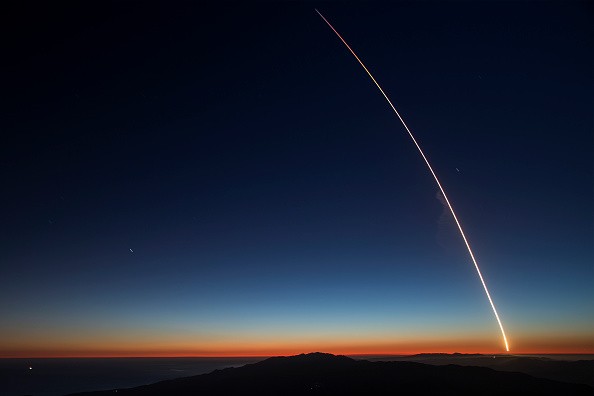Interesting Engineering reports show that Japan's high-altitude platform stations (HAPS) are expected to launch 2025 unmanned aerial vehicles operating in the stratosphere that reportedly provide broader network coverage than the present ground stations.
Japan Today adds that the planned launch comes after a new international agreement was achieved during the World Radiocommunication Conference held in the United Arab Emirates from November 20 to December 15, wherein over 163 countries reportedly participated.

(Photo : David McNew/Getty Images)
The SpaceX Falcon 9 rocket launches from Vandenberg Air Force Base carrying the SAOCOM 1A and ITASAT 1 satellites, as seen during a long exposure on October 7, 2018 near Santa Barbara, California. After launching the satellites, the Falcon 9 rocket successfully returned to land on solid ground near the launch site rather than at sea.
The expected base stations are said to be more effective than ground stations. By emitting radio waves from around 20 kilometers, base stations operating in the stratosphere allow HAPS to offer a higher level of telecommunications connection and coverage than ground-based stations.
This connectivity is anticipated to allow mobile phones to be used in isolated locations and even at sea, helping to close the digital divide in countries with inadequate network infrastructures.
Read Also: Apple, Google, Likely to be Forced by Japan to Allow Third-Party App Stores
HAPS' Global Norms
Interesting Engineering cites that Nikkei Asia reports the conference approved Japan's proposal to establish four frequency bands as global norms for aerial flying stations, opening the door for the technology to be widely deployed globally. The plan calls for utilizing 1.7 gigahertz, 2 GHz, and 2.6 GHz frequencies for flying base stations worldwide.
Furthermore, the same report stated that the 700-900 megahertz (MHz) band, utilized to enhance mobile services in Europe, the Americas, Africa, and certain portions of Asia, was also cleared for usage with flying base stations.
Testing for HAPS has reportedly already started, as per Japan Today, stating that SoftBank Corp., a Japanese mobile phone provider, has successfully tested its HAPS autonomous aircraft in the stratosphere in September, providing Rwanda with a 5G connection.
Nippon Telegraph and Telephone Corp. has also reportedly worked closely with broadcasting provider Sky Perfect JSAT Corp. and other partners in the platform's research and development.
Japan's 'Beyond 5G' Project
A separate report adds that this projected move by Japan follows the Beyond 5G initiative of the nation's National Institute Of Information And Communications Technology (NICT), which aims to create a society where users everywhere have guaranteed connectivity over land, sea, and space.
There are two stages within the project. To expedite the commercialization of HAPS D2D communication services, participating firms will work together to resolve several technological challenges and showcase a communication service using HAPS positioned in the stratosphere above Japan during Phase 1.
Phase 2 aims to broaden the business scope and applicability of HAPS services in the 6G era through research and development on high-speed, high-capacity technologies and time-division duplex (TDD) communication, where the downlink and uplink use the same frequency band but in different time slots.
Interesting Engineering adds that HAPS' technological demonstration is expected to take place during the World Expo 2025, which will take place in Osaka, reportedly catapulting Japanese enterprises to the same degree of prominence as US and Chinese companies that supply telecom equipment to the global market.
Related Article: Japanese Researchers Break Internet Speed Record Using Optical Fiber-How Did They Do It?










